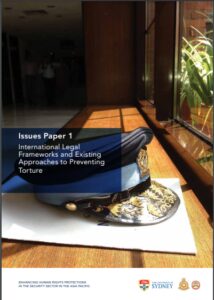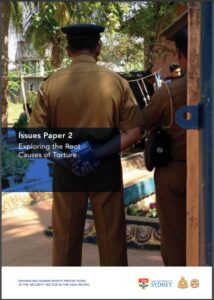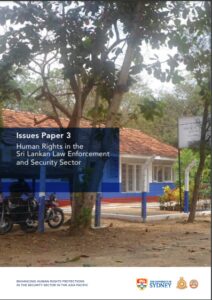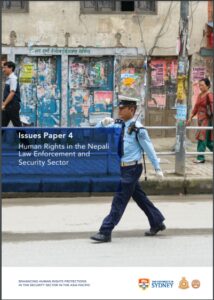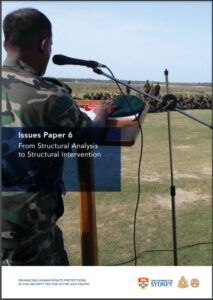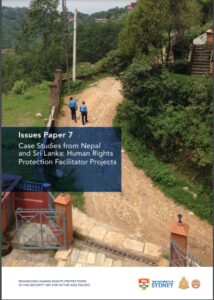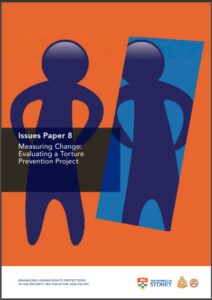CSHR implemented a joint research project on Enhancing Human Rights Protections in the Security Sector in the Asia Pacific Region (EHRP), in collaboration with the University of Sydney, Australia and Kathmandu Law School, Nepal in 2015. The partners jointly developed a series of issues papers on aspects of law enforcement, security sector, and violence in Sri Lanka and Nepal, which are discussed below. Visit https://ehrp.cmb.ac.lk/ for more information on the project.
This first Issues Paper is intended to provide some background to the specific project. Chapter One looks at the international lgal framework that has been established to deal with the class of acts that we are concerned with here. It sets out basic definitions of torture, sanctions against it and the scope of the problem both internationally and in the Asia Pacific, in particular using the framing of international law. In Chapter Two, this Issues Paper examines the main approaches that have been adopted in the last forty years to address the use of torture. In particular it examines which Theory of Change underpins these approaches and what we know about how well they work.
This second Issues Paper discusses the findings of our research on the root causes of the use of torture. Methodologically, we conducted this research in two ways. First, a team of experts examined the root causes of torture or institutional violence from a range of disciplinary perspectives, including political science, public health, psychology, criminology, sociology and anthropology. Second, our teams of country-based researchers conducted primary empirical research in both Sri Lanka and Nepal, speaking with a range of government and civil society actors as well as with members of the security forces about how they understood the problem of torture, the position and experience of security personnel and their perception and understanding of human rights in relation to security work.
Chapter One presents the research on institutional violence. It points to the large body of research indicating that systematic violence is best understood in terms of situational factors, rather than as the outcome of individual pathologies. Here we look in particular at the relevance of obedience and conformity, the types of conditions that produce torture and the processes of moral disengagement that allow for it to be normalised. Chapter Two establishes our multi-dimensional understanding of the root causes of the use of torture and discusses the different spheres (individual, organisational, community, legal, political, cultural and ideological) implicated in the production of torture. This chapter then presents the ecological or systems approach that the research on situational violence suggests and that we adopted as the theoretical framework for the project. Chapter Three returns to our research on root causes, specifically examining the organisational and cultural factors in police and military organisations that create risks for the use of torture. It distinguishes three different dimensions of organisational factors – processes, structures and cultures – and presents the research on how factors operating on each of these dimensions can create opportunities and incentives to use torture or can legitimise, authorise and normalise this. In this chapter we also begin to break down that oft used but opaque term ‘culture’ (policing culture, military culture) so that we can get a handle on how, where and why the use of torture is perpetuated and where interventions seeking to prevent it should be directed.
In Issues Paper 3 and Issues Paper 4, we move from the general to the country specific, presenting what our researchers and others have found about the specific situational factors in Sri Lanka and Nepal. Drawing on our own interview data and on secondary literature, we seek to present a picture of the conditions under which the use of torture may become systematic in the particular contexts of South Asia. In Issues Paper 4 on Nepal, we also draw on research conducted in other contexts, principally in India, to enrich our findings. A separate Issues Paper (9) discussed below is dedicated to describing detailed research on one district in Sri Lanka that was conducted at the end of the overall project.
In the fifth Issues Paper we move from the research concerning root causes to the research on strategies for effecting change. We begin, in Chapter One, with a discussion of our research on strategies to effect organisational and cultural change. Drawing on literature directly concerned with changing security organisations, and broader literatures on transforming organisational norms and practices as well as deep-rooted behaviours and attitudes, we suggest a number of principles and approaches that might be usefully taken up to transform the cultures of security organisations. In Chapter Two, we turn to the cognate area of public health to examine the research on prevention strategies developed in this field. We look at the results of meta-evaluations of projects indicating the key components of successful prevention, discuss the importance of understanding the particular characteristics of the target group and its readiness to change and examine a number of approaches to effecting normative and attitudinal change. Chapter Three then comes back to Nepal and Sri Lanka to discuss the critically important process of enrolling and building relations with the organisations in which change is being sought. Here we discuss how we went about developing those relationships and some of the challenges that we faced in doing so, as well as the design we settled upon for working with Human Rights Protection Facilitators (HRPFs) on the inside of the organisations.
This sixth Issues Paper turns from the research to the design and implementation of our intervention. Chapter One commences with an explanation of how we moved from the research results to developing the Theory of Change that became the foundation for our intervention. It then sets out the basic intervention design. Chapter Two then describes in detail the transition from the design of our prevention approach to its actual implementation. Here we focus in particular on the process of working with the HRPFs to identify organisational risk factors and to design projects that address those factors, our workshop designs and the ongoing capacity building the project team and the HRPFs did together.
The seventh Issues Paper sets out the actual projects that the HRPFs developed. Chapter One discusses in more detail the process that the HRPFs used for developing their projects and how they came to identify the problem they would work on as well as the results they wished to achieve and the actions they needed to take to achieve those results. Chapter Two describes the actual projects, setting out all of the projects in brief and then showcasing some illustrative processes. While Issues Paper 8 is dedicated to evaluation, in the final part of this Issues Paper we also reflect on some of the strengths and weaknesses of the projects and the approach to working from the inside with security personnel themselves taking the lead in this manner.
One of the significant challenges for any project seeking to contribute to the prevention of a serious and complex human rights violation is evaluating its impact. As such, Issues Paper 8 is dedicated to the question of evaluation. Chapter One discusses some of the literature and general approaches to evaluation in the human rights field and the difficulties and importance of developing evaluation methods that will assist in drawing as many lessons as possible from projects. Chapter Two discusses how we planned our evaluation processes and the need for a multi-layered evaluation capable of addressing the different components of the project. Chapter Three presents some of the findings for evaluating the research we conducted, the intervention we developed and how well we achieved our results and objectives.
Although the principal purpose of conducting research in the EHRP was to develop an intervention design, at the end of the project we conducted in-depth research into the situation concerning policing in one district in Sri Lanka. We did this because our work during the project had made it clear that the best possible intervention designs would be based on a very detailed understanding of a particular context, the human rights problems, the different stakeholders and the way in which different sectors in that area understood the problem and their capacity to develop solutions. In Sri Lanka we were given permission to conduct in depth research, including with police in one district in the North West, Puttalam. This Issues Paper sets out this research, discussing in depth our findings about the contextual factors and the dynamics of violence.
In addition to the Issues Papers, we also produced a report on the International Conference. Chapter One of the Conference Report contextualises the conference in the overall EHRP and sets out its objectives. Chapter Two describes the process for planning the Conference and how we went about ensuring the involvement of a range of stakeholders. Chapter Three describes the way in which we organised the actual conference agenda and activities, describing the key themes, the questions we chose as the basis for the conference discussions and the formats we adopted. Chapter Four provides a detailed summary of the conference sessions and discussions including selected excerpts from the presentations. Chapter Five and Appendix C look in some detail at the conflicts and controversy surrounding the conference. Finally, in Chapter Six we reflect on some lessons that emerged from the Conference, drawing on the reflections of conference participants.
